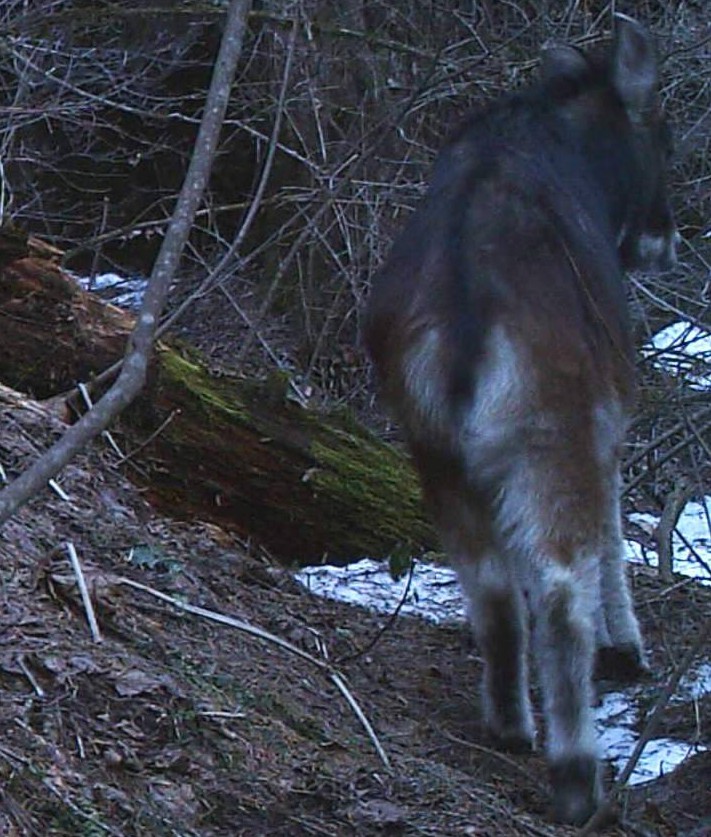
Capricornis thar (Himalayan serow)
The Himalayan serow (Capricornis thar) is a shy and solitary goat-antelope found in the dense forests and rocky terrains of the Great Himalayan National Park (GHNP). This elusive mammal plays a vital ecological role and is often spotted along steep slopes and forested ridges within the park’s mid to high-altitude zones.
Physical Characteristics
The Himalayan serow has a robust build, thick dark fur, and short, backward-curving horns. Its coat varies from black to dark brown, with lighter patches on the face and neck. With a strong neck and muscular limbs, it is well-adapted to maneuvering through steep, rugged landscapes and dense vegetation.
Habitat and Range in GHNP
The Himalayan serow primarily inhabits elevations between 2,000 to 3,500 meters, preferring areas with a mix of forest cover and open cliffs for both feeding and escape from predators. In GHNP, it is often found in remote areas of Tirthan and Sainj valleys, where human disturbance is minimal.
| Common name | Himalayan Serow. |
| Latin name | Capricornis thar Hodgson 1831 |
| Local name | Jingal ,Yemu, |
| IUCN/WPA/Indian status | Near threatened/I/Occasional |
| Social unit | Seen solitary or in small groups of less than10 animals, commonly in one and twos SIZE :HBL: 140-170 cm. HAS : 90-100 cm. HL : 16-34 cm.(male), HG: 10-15 cm (female) Weight : 85-140 kg.or in small groups of less than10 animals, commonly in one and twos |
| Size / weight | HBL: 140-170 cm. HAS : 90-100 cm. HL : 16-34 cm.(male), HG: 10-15 cm (female) Weight : 85-140 kg. |
| Description | An appearance of a goat with long, donkey like ears, and a habit of standing with forelegs astraddle, make the Serow an ungainly goat antelope. Its coarse coat(long hair length than the Goral) varies from black to red. In the typical form, both sexes have a coarse dark, sometimes salt and pepper mane and a dark dorsal stripe that is more evident in some individuals than others. The ears are ovate and long like a donkey, with creamy white hairs inside, fringed black. The tail is dark. |
| Behavior | When alarmed , the Serow bounds away with what has been variously described as a hissing snort or a whistling scream. |
| Distribution | The dark form in the southern slopes of Himalayas from Jammu & Kashmir in west to Arunachal Pradesh in the east, the enigmatic red form in the hills of Arunachal Pradesh, Meghalaya, Manipur, Mizoram, Tripura and Nagaland. |
| Habitat | Thickly forested gorges, broadleaved valleys, and subalpine scrub with dense cover snd boulder strewn hills (300-3000 m) |
| Best seen | Himalayan form Kedarnath WLS, Uttarakhand, Red form : Mahadeo WLS , Arunachal Pradesh |
Behavior and Diet
This species is mostly solitary and crepuscular, meaning it is most active during dawn and dusk. The serow is a browser, feeding on a wide variety of plant material including leaves, grasses, shoots, and shrubs. It is highly alert and elusive, making it a rare but rewarding sight for wildlife enthusiasts in GHNP.
Conservation and Threats
Listed as Vulnerable by the IUCN, the Himalayan serow faces threats from habitat loss, poaching, and human disturbance. Within the protected boundaries of the Great Himalayan National Park, however, it finds refuge and protection. Conservation efforts in the park, including strict anti-poaching patrols and community-based awareness programs, have been instrumental in supporting this species.
Role in Ecosystem
The Himalayan serow contributes to the ecological balance by regulating vegetation through its feeding habits and serving as prey for predators like the snow leopard and Himalayan wolf. Its presence indicates a healthy forest ecosystem in GHNP.



